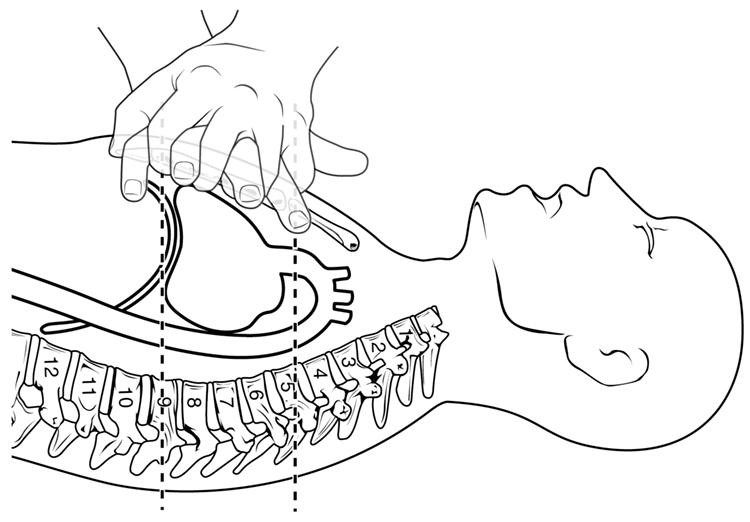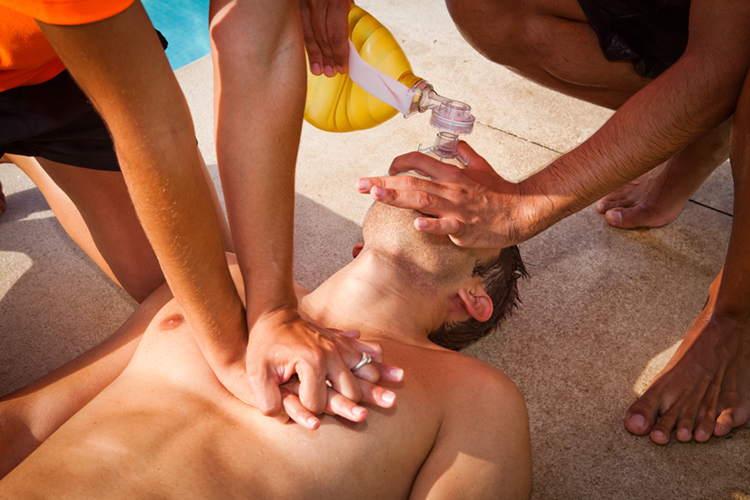Cardiopulmonary resuscitation (CPR) is an emergency procedure used when someone suffers a cardiac arrest, collapses, and stops breathing.
Cardiopulmonary resuscitation increases survival chances and saves lives because it can preserve brain function until emergency services arrive.
Without oxygen moving from the lungs to the bloodstream and then being pumped by the heart to the rest of the body, the person will suffer irreparable brain damage and die within minutes.
So, basically, CPR is a first-aid technique that restores blood circulation to someone whose heart stopped beating.
CPR is a way of providing artificial circulation of oxygenated blood flow via chest compressions.
When you push fast and hard on the sternum, the heart gets compressed and pumps blood to the brain and other critical organs.
CPR is performed on victims who are unresponsive and not breathing.
The good news is that anyone can learn these life-saving skills. You don't need to be a healthcare professional to perform CPR on a victim.
In 90 percent of the cases, it's friends and family who save lives. The need for CPR can happen almost everywhere - at the beach, on the street, in a stadium, at school, or in a shopping mall.
C-A-B: The CPR Technique
In 2010, the American Heart Association (AHA) rearranged the order of CPR's basic steps. Today, the rule of thumb is C-A-B, i.e.:
- C - Chest compressions;
- A - Airway;
- B - Breathing;
Before starting CPR, make sure the area around you is safe. Then, shake the person gently by the shoulders and ask: "Are you alright?"
If there is no response and the person is not breathing normally, call 911, and take the following CPR steps:
- Place the heel of one hand at the center of the chest (near the end of the breastbone);
- Interlock your fingers and place the hands on the victim's chest;
- With arms straightened, press down hard (about two inches or five centimeters) and fast (compressions at a rate of 100-120 compressions per minute, i.e., around two times every second), letting the chest rise and come back fully each time;
- With proper CPR and first aid training classes, you may give two rescue breaths after cycles of 30 chest compressions to provide oxygen;
- To do so, open the victim's airway by lifting the chin and tilting the head backward. Then, pinch the nostrils to close the nose and open the mouth with the help of the chin;
- Remember that the two breaths should not take more than five seconds. Continue the CPR until the casualty resumes breathing;
If you have not been trained or are not comfortable with the technique, just keep going with the hands-only CPR and continuous chest compressions procedure.
Don't stop until a health professional or an ambulance arrives or the person starts breathing again.
CPR on Women
One of the most common myths is that men or bystanders might be sued for performing CPR on women because they fear being accused of sexual assault.
Studies have confirmed that women are much less likely than men to receive CPR from a bystander and more likely to die. Why? Because people are too afraid to touch a woman's chest in public.
If the person's heart is not beating and she is not breathing, then she's technically dead. So, what more harm can you do?
Always remember that if you're helping any patient, and if they come back to life, the Good Samaritan laws will always protect you.
And if you're actually performing CPR correctly on a woman, you're not even touching her breasts - you should go right in the center of the chest.
Every year, around 400,000 Americans suffer a heart attack or cardiac incident outside the hospital, so it's critical to start doing the right thing on time.

Using an Automatic External Defibrillator
If available nearby, the Automatic External Defibrillator (AED) can replace manual CPR.
All you need to do is remove the person's clothes and attach the AED pads to the victim's chest as instructed on the device.
Once the pads are attached, do not touch the person, and wait until the AED analyzes the patient's heart rhythm.
If the AED indicates that a shock is needed, stand clear and press the "shock" button.
Once the shock is delivered, resume CPR until the person regains consciousness.
Formal CPR Certification and CPR Training Classes
As an emergency life-saving procedure, cardiopulmonary resuscitation has standard guidelines that must be followed in order to be effective and successful.
Therefore, official CPR certification will always be the ideal pathway to learning the first-aid technique.
If you're willing to help others, enroll in a CPR course. Whether you're a surfer, teacher, businessman, nurse, or social worker, you can make a difference and save someone's life.
There are several learning formats available - classroom, online, or both - with prices ranging from $80 to $125.
Visit the American Red Cross and the American Heart Association (AHA) for official training and certification.
